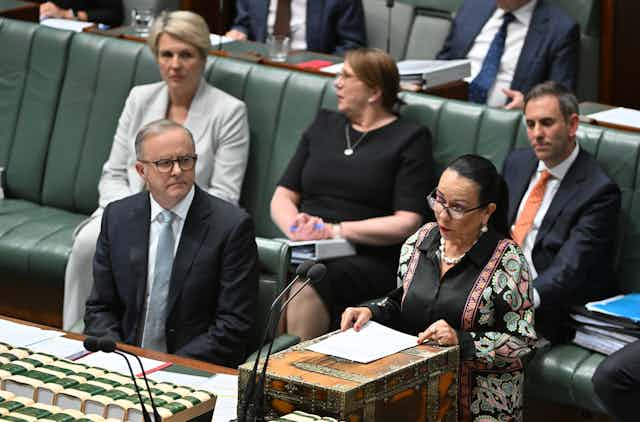A key part of the 2023 budget was a pledge to “achieve a better future” for Indigenous Australians through measures that would make a “practical difference”.
This included a particular focus on the Northern Territory, with a A$250 million commitment for Central Australia. Of this, more than $40 million was set aside to improve school attendance in these local communities.
While the emphasis on Indigenous students is welcome, it is important to acknowledge there has been no quick fix for Indigenous education to date, and the focus would be better placed on the education system as a whole.
“Indigenous deficit” – where Indigenous issues are framed as a “problem” that needs fixing – is a thriving industry. Here we see a lot of government money spent, but not enough long-term change or improvement for Indigenous Australians.
The budget papers
The budget papers included a glossy Empowering Aboriginal and Torres Strait Islander people booklet. This eight-page document emphasises key principles, such as the need to work in partnership with the local community, the need for system-wide change of government organisations and an elevated First Nations voice in decision-making.
But actions speak louder than words. While local community partnership and an elevated voice may be achievable with substantial effort, system-wide change of any government organisation is very unlikely without a paradigm shift within the organisation.
The booklet also includes a section on Central Australia, which has been a national focus in recent months, with the reporting of a youth crime wave.
Read more: Beneath the Alice Springs 'crime wave' are complex issues – and a lot of politics
This has indubitably prompted the government’s budget announcement of $40.4 million for On-Country Learning “to improve school attendance, engagement and learning outcomes” for students in Central Australian schools.
On-Country Learning is an approach to teaching that incorporates Indigenous knowledges, confirms ties to Country and Indigenous sovereignty, and implies more of a remote focus.
Culturally appropriate education
In a separate measure – included under “economic empowerment” – there is $38.4 million to support “culturally appropriate” education for First Nations children, “with a focus on remote areas”.
The idea that Indigenous students in remote areas struggle compared to their urban counterparts has been an ongoing issue – as reported annually in NAPLAN results. The more remote the students are, the greater difficulty there is with meeting the minimum literacy and numeracy standards of our westernised education system.
Often these debates fail to take into consideration how assessments can be culturally biased and how students in remote areas may not speak English as their first language.
Teachers need to be better educated
Both of the funding measures announced require teachers, the majority of who are non-Indigenous, to be educated about Indigenous Australia. Expert teachers who are confident and capable are needed to teach Indigenous content and in Indigenous contexts such as On-Country.
Unfortunately, many teachers feel under-confident and under-prepared. It could be argued perhaps Indigenous voices in education have not been heard or listened to. Indigenous academics have been striving for many years to change this.
Read more: Is policy on Indigenous education deliberately being stalled?
The Australian Institute for Teaching and School Leadership has also recently produced cultural competency resources for teachers.
Teachers need more training and support and there needs to be accountability within the education system. In other words, there must be ways of ensuring teachers achieve these skills, as required in the Australian Professional Standards for Teachers.
Urban vs remote
We also need to consider how Alice Springs, where the crime wave was reported, is categorised as “urban”.
So, where is the specific funding to support Indigenous education in urban settings? Much of the funding and research focuses on remote Indigenous issues and assumes Indigenous people living in cities are catered for by so-called mainstream systems in place for non-Indigenous people.
If events in Alice Springs are anything to go by, obviously this is not the case. More funding and research should be used to investigate and understand the Indigenous urban experience and improve Indigenous educational outcomes across all regions.
We need more Indigenous teachers
Another issue to consider is the lack of Indigenous teachers. These teachers already have Indigenous cultural understandings and perspectives required. The federal government-funded More Aboriginal and Torres Strait Islander Teacher Initiative attempted to increase Indigenous teacher numbers but funding stopped in 2016.
About 3.2% of the Australian population identify as Indigenous, while roughly 2% of the teaching workforce identify as Indigenous.
The significance of these statistics changes for Northern Territory contexts where approximately 32% of the population identify as Indigenous. It is understood the proportion of Indigenous teachers in the NT is slightly higher than the rest of the country, but there are no publicly available official figures.
The NT Department of Education has a Remote Aboriginal Teacher Education program to increase teacher numbers in remote schools. There should also be focus on increasing Indigenous teacher numbers in urban areas.
More funds do not guarantee change
It is wonderful the federal government understands change is needed in Indigenous education and this can only be done with strategy and funding.
But success is not the provision of more funds.
This will depend on the the way this is used to make effective change. And this will not happen without deeper cross-cultural understandings and engagement.
In the article, the terms Aboriginal and Torres Strait Islander, Indigenous, and First Nations have been used interchangeably.

